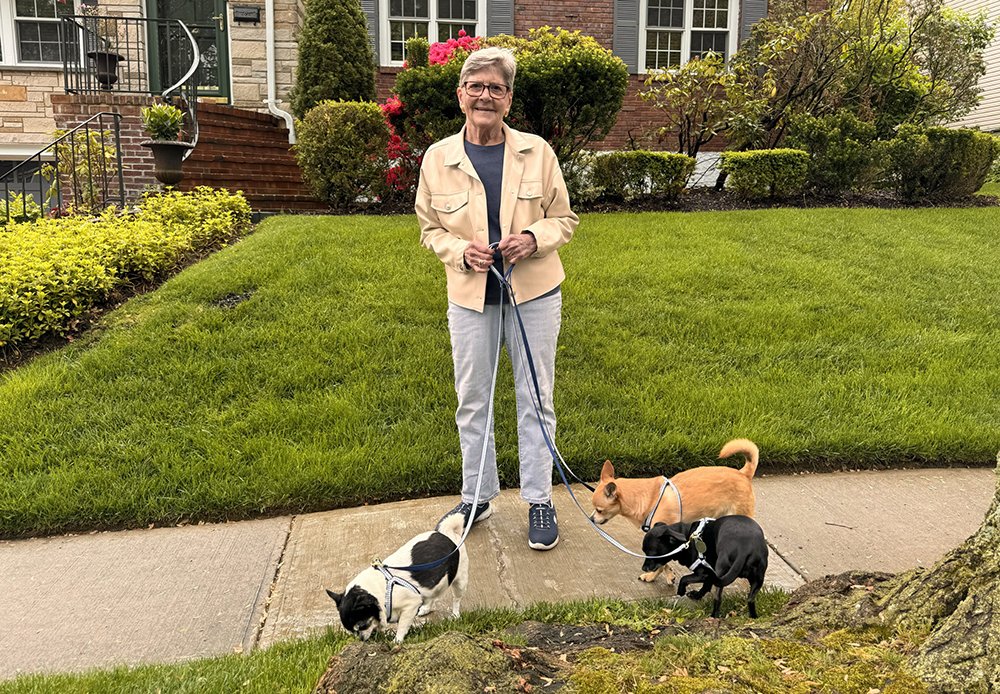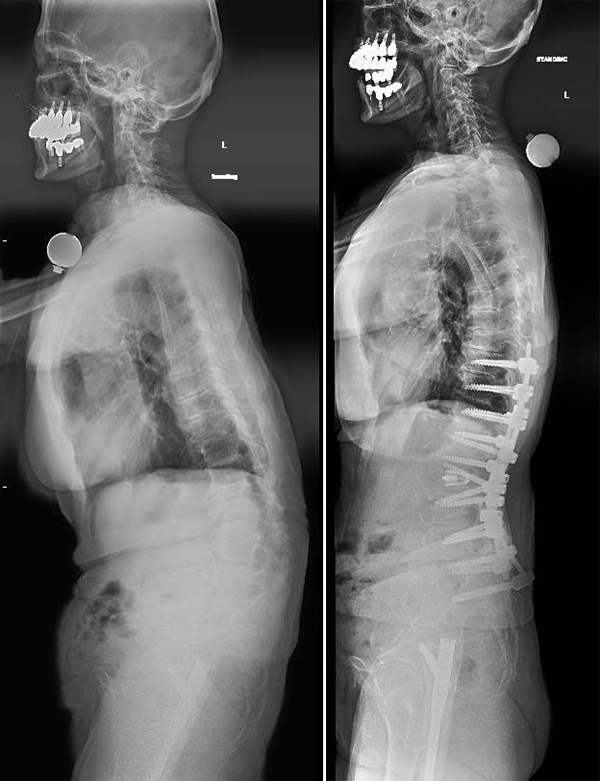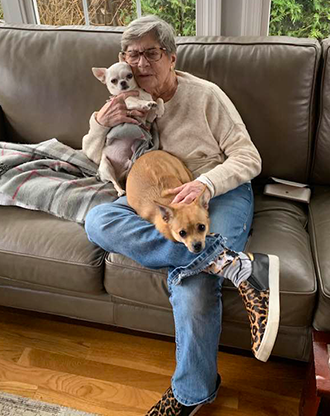
Pat Cusick had mild scoliosis for many years, but it never bothered her. The Staten Island woman had an active life, even taking a retirement job as a school nurse after a long career in nursing, which included teaching in an associate degree-granting program and as an administrator in long-term care and rehabilitation facilities. But as she neared 70, she noticed she was starting to appear “a little bent over.” Then one day a student pushed her against a cinderblock wall, and that’s when the pain started. The scoliosis was worsening, and she was having a hard time recovering from the injury. It’s been a long journey since then, but today Pat is back on her feet at 80 — driving, caring for half a dozen animal companions, and very happy that Dr. Michael Virk has given her her life back.
Early on, in search of options, Pat had gone to a local clinic that brought in an orthopedic surgeon for consults — the surgeon evaluated her and looked at her images, but was not optimistic about a surgical solution. “He said he hated doing those kinds of surgeries,” Pat laughs now. “That was not promising!”

With her posture and pain worsening, Pat needed solutions. “It was limiting my life,” she says. “It hurt to drive, and I couldn’t walk my dogs more than about 300 feet.” She particularly hated how her bent-over posture made her shirts ride up in the back, but it was the prospect of real disability that she could not accept. “A wheelchair is not my thing!” she exclaims, but doctors warned her there was likely one in her future. That, says Pat, was not how she wanted to spend her retirement.
Pat talked to her primary doctor about her options. The doctor had recently sent a patient for surgery with Dr. Michael Virk at Och Spine at NewYork-Presbyterian/Weill Cornell Medical Center and had been amazed at how well that patient had done. Perhaps Pat would like to talk to Dr. Virk about surgical options for her scoliosis?
“I looked Dr. Virk up online, and he seemed terrific,” Pat recalls. In person, Dr. Virk did not disappoint — Pat says he was very understanding and caring, even as he cautioned her that scoliosis surgery was lengthy and complex, not easy on someone her age. Still, she was hopeful that this was the solution she needed.
“Adult degenerative scoliosis affects people in different ways, and some people are able to remain quite well compensated throughout their lives,” says Dr. Virk. “For others, however, scoliosis can be a source of tremendous disability. Spinal degeneration generally involves disc degeneration, facet joint arthropathy, and muscle atrophy, and neural element compression is often involved. These degenerative changes can accumulate and cause asymmetry in the vertebral column that results in pain and difficulty with basic daily functions. Once it progresses to this extent, surgical treatment may be a reasonable consideration. It can be a particularly challenging problem in patients who have had prior surgery, like Ms. Cusick.”
There was, however, one bump in the road: A prescription for denosumab (Prolia) that had been intended to prevent osteoporosis had instead caused a rare side effect when Pat suffered a fractured femur (thigh bone). “It’s ironic that a medicine to protect my bones ended up breaking one!” she says. Dr. Virk told her he could not operate on her back while the fracture was still healing, and he told her she’d have to wait at least eight months before he could consider operating on her.
“I wasn’t the least bit scared. I knew I was in good hands, and I had total faith in Dr. Virk.”
Undeterred, Pat waited the eight months and then called Dr. Virk again, determined to find a lasting solution and get back on her feet. At 79, Pat was considered high risk for a daylong surgery, so Dr. Virk took her case to the multidisciplinary, high-risk medical evaluation conference for review. Since she was otherwise healthy and strong, Pat was cleared for surgery.
“I wasn’t the least bit scared that day,” Pat remembers. “I knew I was in good hands, and I had total faith in Dr. Virk.”
The surgery was as extensive as Dr. Virk had predicted: eight hours of spine surgery, during which he implanted three rods, an interbody cage, and 16 screws, followed by closure with plastic surgeon David Otterburn. Pat’s bent spine was now straight — no more bent-over posture, no more shirts riding up her back.

Scans of Pat Cusick's spine, before and after her corrective surgery for scoliosis
“Ms. Cusick did remarkably well,” says Dr. Virk. “She is strong and motivated, with tremendous resolve to pursue her independence. Scoliosis surgery must be carefully considered, along with the complication spectrum, but can be quite rewarding for patients. Ms. Cusick is a remarkable person and her outlook on life is inspirational.”
"I had to spend a full week in rehab, even though I met my physical therapy goals on the first day,” laughs Pat. “I wanted to leave, but Dr. Virk told me I had to stay a full week to be safe. I felt better once I was home, and I was back to driving a week or so after that. Dr. Virk warned me about ‘BLT’ [the ‘bending, lifting, or twisting’ that could derail her progress] so I needed help taking care of my dogs and cats, but other than that I did fine.”

A year after her surgery, Pat is doing well. A friend helps with dog walking just to be sure her three pups don’t pull her over, but she is otherwise self-sufficient. She walks two or three miles every day and volunteers with a local cat rescue organization. In short, this is the retirement she had in mind — with not a wheelchair in sight.
Michael Virk, M.D., Ph.D. is a board-certified neurosurgeon specializing in minimally invasive and complex spine surgery. He is committed to a patient-centered, multidisciplinary approach to treat his patients. Call his office at 646-962-3388 for a consultation.